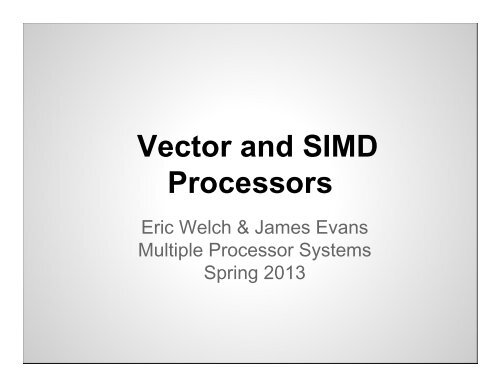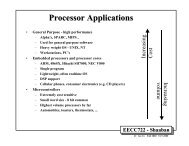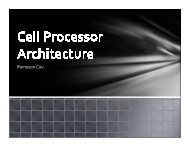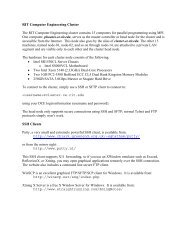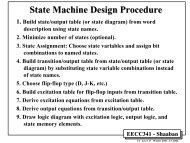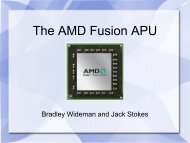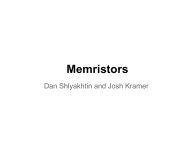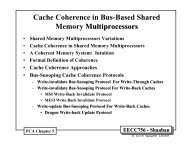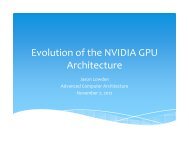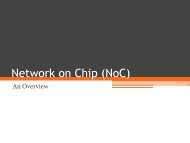Vector and SIMD Processors
Vector and SIMD Processors
Vector and SIMD Processors
You also want an ePaper? Increase the reach of your titles
YUMPU automatically turns print PDFs into web optimized ePapers that Google loves.
<strong>Vector</strong> <strong>and</strong> <strong>SIMD</strong><br />
<strong>Processors</strong><br />
Eric Welch & James Evans<br />
Multiple Processor Systems<br />
Spring 2013
Outline<br />
• Introduction<br />
• Traditional <strong>Vector</strong> <strong>Processors</strong><br />
o<br />
o<br />
o<br />
o<br />
o<br />
History & Description<br />
Advantages<br />
Architectures<br />
Components<br />
Performance Optimizations<br />
• Modern <strong>SIMD</strong> <strong>Processors</strong><br />
o<br />
o<br />
o<br />
Introduction<br />
Architectures<br />
Use in signal <strong>and</strong> image processing
History of <strong>Vector</strong> <strong>Processors</strong><br />
• Early Work<br />
o Development started in the early 1960s at Westinghouse<br />
• Goal of the Solomon project was to substantially increase arithmetic<br />
performance by using many simple co-processors under the control of<br />
a single master CPU<br />
• Allowed single algorithm to be applied to large data set<br />
• Supercomputers<br />
o Dominated supercomputer design through the 1970s into the 1990s<br />
o<br />
o<br />
Cray platforms were the most notable vector supercomputers<br />
• Cray -1: Introduced in 1976<br />
• Cray-2, Cray X-MP, Cray Y-MP<br />
Demise<br />
• In the late 1990s, the price-toperformance<br />
ratio drastically<br />
increased for conventional<br />
microprocessor designs
Description of <strong>Vector</strong> <strong>Processors</strong><br />
• CPU that implements an instruction set that operates on<br />
1-D arrays, called vectors<br />
• <strong>Vector</strong>s contain multiple data elements<br />
• Number of data elements per vector is typically referred<br />
to as the vector length<br />
• Both instructions <strong>and</strong> data are pipelined to reduce<br />
decoding time<br />
SCALAR<br />
(1 operation)<br />
r1<br />
+<br />
r3<br />
r2<br />
add r3, r1, r2<br />
VECTOR<br />
(N operations)<br />
v1<br />
v2<br />
+<br />
v3<br />
vector<br />
length<br />
add.vv v3, v1, v2
Advantages of <strong>Vector</strong> <strong>Processors</strong><br />
• Require Lower Instruction B<strong>and</strong>with<br />
o Reduced by fewer fetches <strong>and</strong> decodes<br />
• Easier Addressing of Main Memory<br />
o Load/Store units access memory with known patterns<br />
• Elimination of Memory Wastage<br />
o<br />
o<br />
Unlike cache access, every data element that is requested by the<br />
processor is actually used – no cache misses<br />
Latency only occurs once per vector during pipelined loading<br />
• Simplification of Control Hazards<br />
o Loop-related control hazards from the loop are eliminated<br />
• Scalable Platform<br />
o<br />
Increase performance by using more hardware resources<br />
• Reduced Code Size<br />
o<br />
Short, single instruction can describe N operations
<strong>Vector</strong> Processor Architectures<br />
• Memory-to-Memory Architecture (Traditional)<br />
o For all vector operation, oper<strong>and</strong>s are fetched directly from<br />
main memory, then routed to the functional unit<br />
o Results are written back to main memory<br />
o Includes early vector machines through mid 1980s:<br />
o<br />
• Advanced Scientific Computer (TI), Cyber 200 & ETA-10<br />
Major reason for demise was due to large startup time
<strong>Vector</strong> Processor Architectures (cont)<br />
• Register-to-Register Architecture (Modern)<br />
o All vector operations occur between vector registers<br />
o If necessary, oper<strong>and</strong>s are fetched from main memory into<br />
a set of vector registers (load-store unit)<br />
o Includes all vector machines since the late 1980s:<br />
o<br />
• Convex, Cray, Fujitsu, Hitachi, NEC<br />
<strong>SIMD</strong> processors are based on this architecture
Components of <strong>Vector</strong> <strong>Processors</strong><br />
• <strong>Vector</strong> Registers<br />
o<br />
o<br />
o<br />
o<br />
Typically 8-32 vector registers with 64 - 128 64-bit elements<br />
Each contains a vector of double-precision numbers<br />
Register size determines the maximum vector length<br />
Each includes at least 2 read <strong>and</strong> 1 write ports<br />
• <strong>Vector</strong> Functional Units (FUs)<br />
o<br />
o<br />
o<br />
Fully pipelined, new operation every cycle<br />
Performs arithmetic <strong>and</strong> logic operations<br />
Typically 4-8 different units<br />
• <strong>Vector</strong> Load-Store Units (LSUs)<br />
o<br />
Moves vectors between memory <strong>and</strong> registers<br />
• Scalar Registers<br />
o<br />
Single elements for interconnecting FUs, LSUs, <strong>and</strong> registers
Performance Optimizations<br />
• Increase Memory B<strong>and</strong>width<br />
o Memory banks are used to reduce load/store latency<br />
o Allow multiple simultaneous outst<strong>and</strong>ing memory requests<br />
• Strip Mining<br />
o Generates code to allow vector oper<strong>and</strong>s whose size is less than or greater<br />
than size of vector registers<br />
• <strong>Vector</strong> Chaining<br />
o Equivalent to data forwarding in vector processors<br />
o Results of one pipeline are fed into oper<strong>and</strong> registers of another pipeline<br />
• Scatter <strong>and</strong> Gather<br />
o Retrieves data elements scattered thorughout memory <strong>and</strong> packs them<br />
into sequential vectors in vector registers<br />
o Promotes data locality <strong>and</strong> reduces data pollution<br />
• Multiple Parallel Lanes, or Pipes<br />
o Allows vector operation to be performed in parallel on multiple elements of<br />
the vector
<strong>Vector</strong> Chaining Example
Organization of Cray Supercomputer
Performance of Cray Supercomputers
Modern <strong>SIMD</strong> Introduction<br />
• Single Instruction Multiple Data is part of Flynn's taxonomy<br />
(not MIMD as discussed in class)<br />
• Performs same instruction on multiple data points<br />
concurrently<br />
• Takes advantage of data level parallelism within an<br />
algorithm<br />
• Commonly used in image <strong>and</strong> signal processing<br />
applications<br />
o Large number of samples or pixels calculated with the same instruction<br />
• Disadvantages:<br />
o Larger registers <strong>and</strong> functional units use more chip area <strong>and</strong> power<br />
o Difficult to parallelize some algorithms (Amdahl's Law)<br />
o Parallelization requires explicit instructions from the programmer
<strong>SIMD</strong> Processor Performance Trends<br />
<strong>SIMD</strong> <strong>and</strong><br />
MIMD<br />
<strong>SIMD</strong>
Modern <strong>SIMD</strong> <strong>Processors</strong><br />
• Most modern CPUs have <strong>SIMD</strong> architectures<br />
o Intel SSE <strong>and</strong> MMX, ARM NEON, MIPS MDMX<br />
• These architectures include instruction set extensions<br />
which allow both sequential <strong>and</strong> parallel instructions<br />
to be executed<br />
• Some architectures include separate <strong>SIMD</strong> coprocessors<br />
for h<strong>and</strong>ling these instructions<br />
• ARM NEON<br />
o Included in Cortex-A8 <strong>and</strong> Cortex-A9 processors<br />
• Intel SSE<br />
o Introduced in 1999 in the Pentium III processor<br />
o<br />
SSE4 currently used in Core series
<strong>SIMD</strong> Processor Introduction<br />
128 bits<br />
VLD.32 Q1, 0x0<br />
Q1<br />
M[3] M[2] M[1] M[0]<br />
VLD.32 Q2, 0x8<br />
Q2<br />
M[11] M[10] M[9] M[8]<br />
VADD.U32 Q3, Q2, Q1<br />
Q3<br />
M[3]+M[11] M[2]+M[10] M[1]+M[9] M[0]+M[8]<br />
VST.32 Q3, 0x10<br />
0x10<br />
0x11<br />
M[0]+M[8]<br />
M[1]+M[9]<br />
non-<strong>SIMD</strong><br />
8 load instructions<br />
4 add instructions<br />
4 store instructions<br />
<strong>SIMD</strong><br />
2 load instructions<br />
1 add instruction<br />
1 store instruction<br />
0x12<br />
M[2]+M[10]<br />
16 total instructions<br />
4 total instructions<br />
0x13<br />
M[3]+M[11]<br />
Possible Speedup = 4
ARM NEON <strong>SIMD</strong> Architecture<br />
• 16 128-bit <strong>SIMD</strong><br />
registers<br />
• Separate<br />
sequential <strong>and</strong><br />
<strong>SIMD</strong> processors<br />
• Both have access<br />
to same L2 cache<br />
but separate L1<br />
caches<br />
• Instructions<br />
fetched in ARM<br />
processor <strong>and</strong><br />
sent to NEON<br />
coprocessor<br />
ARM Processor<br />
NEON Coprocessor<br />
ARM Cortex-A8 Processor <strong>and</strong> NEON <strong>SIMD</strong> coprocessor
Intel SSE <strong>SIMD</strong> Architecture<br />
• Streaming <strong>SIMD</strong><br />
Extensions<br />
• 16 128-bit registers<br />
• <strong>SIMD</strong> instructions<br />
executed along with<br />
sequential instructions<br />
• Adds floating point<br />
operations to Intel's<br />
MMX <strong>SIMD</strong><br />
Intel Core Architecture<br />
Combined SSE Functional Units
Software Programming<br />
• Intel <strong>and</strong> ARM both have vectorizing compilers which<br />
will compile code using <strong>SIMD</strong> instructions<br />
• Many audio/video <strong>SIMD</strong> libraries available<br />
• To achieve best performance, custom coding at the<br />
assembly level should be used
Specialized Instructions<br />
• NEON <strong>SIMD</strong><br />
o VZIP – Interleaves two vectors<br />
o VMLA – Multiply <strong>and</strong> accumulate<br />
o VRECPE – Reciprocal estimate<br />
o VRSQRTE – Reciprocal square root estimate<br />
• Intel SSE4<br />
o PAVG – <strong>Vector</strong> average<br />
o DPPS, DPPD – Dot product<br />
o PREFETCHT0 – Prefetch data into all cache levels<br />
o MONITOR, MWAIT – Used to synchronize across threads
Performance Impact of <strong>SIMD</strong><br />
• NEON on Cortex-A8 with gcc compiler<br />
• Applied to an image warping algorithm<br />
o Mapping a pixel from a source to destination image by an offset<br />
o Calculated on four pixels in parallel (max speedup = 4)<br />
• Two vectorization methods<br />
o Intrinsics - Using intrinsic functions to vectorize<br />
o Manual - <strong>Vector</strong>izing using instructions at the assembly level<br />
Original Intrinsics Manual<br />
Execution time<br />
(s)<br />
10.01 4.56 3.24<br />
Speedup Comparison 1.000of different <strong>SIMD</strong> 2.195 programming methods 3.090
Performance Impact of <strong>SIMD</strong><br />
• SSE on Intel i7 <strong>and</strong> AltiVec on IBM Power 7 processors<br />
• <strong>SIMD</strong> applied to Media Bench II which contains<br />
multimedia applications for encoding/decoding media<br />
files (JPEG, H263, MPEG2)<br />
• Tested three compilers with three methods:<br />
o Auto <strong>Vector</strong>ization - No changes to code<br />
o Transformations - Code changes to help compiler vectorize<br />
o Intrinsics - Functions which compile to <strong>SIMD</strong><br />
Method XLC ICC GCC<br />
Auto<br />
<strong>Vector</strong>ization<br />
1.66 (52.94%) 1.84<br />
(71.77%)<br />
1.58 (44.71%)<br />
Transformations 2.97 2.38 -<br />
Average speedup <strong>and</strong> parallelizable loops for Media Bench II<br />
Intrinsics 3.15 2.45 -
Conclusions<br />
• <strong>Vector</strong> processors provided the early foundation for<br />
processing large amounts of data in parallel<br />
• <strong>Vector</strong> processing techniques can still be found in video<br />
game consoles <strong>and</strong> graphics accelerators<br />
• <strong>SIMD</strong> extensions are a decendant of vector processors<br />
<strong>and</strong> included in most modern processors<br />
• Challenging programming <strong>and</strong> Amdahl’s Law are the<br />
main factors limiting the performance of <strong>SIMD</strong>
Questions?


